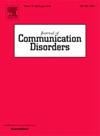Effect of feedback type and self-selected practice schedule on speech fluency during aphasia script treatment
IF 2.1
3区 医学
Q2 AUDIOLOGY & SPEECH-LANGUAGE PATHOLOGY
引用次数: 0
Abstract
Introduction
Aphasia, particularly in persons with nonfluent aphasia (PWNA), disrupts speech fluency. Script treatment—delivered with recursive self-feedback (RSF) or external feedback (EF)—has been shown to improve fluency in PWNA. Evidence from anomia treatment suggests that structured practice schedule (continuous vs. discontinuous) may further influence outcomes. However, it remains unknown how feedback type and PWNA’s self-selected practice schedules—reflecting the variability of real-life routines—interact to influence language outcomes. This study introduces a novel self-selected practice schedule approach and examines its interaction with feedback type on speech fluency in PWNA.
Method
Using a cross-over design, four PWNA engaged in script production with RSF or EF over two intensive treatment blocks. They practiced for two hours daily across two to three weeks per block. The outcome metrics were speaking rate and speech initiation latency. Flexible practice schedules were allowed, where participants selected between continuous (intensive) or discontinuous (spaced) practice across sessions during each treatment block. Approximately 25,000 speech samples, collected across both treatments’ sessions, were analyzed using linear mixed-effects models.
Results
RSF showed a slower gradual increase in speaking rate over time but greater improvement in speech initiation latency than EF over the course of treatment. The discontinuous practice schedule was associated with significantly greater gains in both outcome metrics. Discontinuous practice schedule particularly influenced improvement in speaking rate during script production with RSF.
Conclusion
By introducing self-selected practice scheduling, this work advances more ecologically valid and personalized models of aphasia intervention. Based on our findings, we hypothesize that a discontinuous, spaced practice schedule may be particularly well-suited for RSF and other errorful-based approaches in promoting language recovery in real-world context. Future research with larger and diverse samples of persons with aphasia should test this hypothesis.
反馈方式和自选练习计划对失语脚本治疗中言语流畅性的影响
失语症,尤其是非流利性失语症(PWNA)患者,会破坏语言的流畅性。使用递归自我反馈(RSF)或外部反馈(EF)进行的脚本处理已被证明可以提高PWNA的流畅性。来自失范症治疗的证据表明,有组织的练习计划(连续或间断)可能进一步影响结果。然而,反馈类型和PWNA自我选择的练习时间表(反映了现实生活常规的可变性)如何相互作用来影响语言结果仍是未知的。本研究提出了一种新的自我选择练习时间表方法,并探讨了其与反馈类型对PWNA语音流畅性的影响。方法采用交叉设计,在两个强化治疗区块中,4名PWNA参与RSF或EF的剧本制作。他们每天练习两小时,每个街区练习两到三周。结果指标为语速和语音起始延迟。允许灵活的练习时间表,参与者可以在每个治疗块期间选择连续(密集)或间断(间隔)练习。在两种治疗过程中收集的大约25,000个语音样本使用线性混合效应模型进行了分析。结果在治疗过程中,rsf表现出较慢的语速逐渐增加,但在言语开始潜伏期方面比EF有更大的改善。不连续的练习计划与两种结果指标的显著更大的收益相关。在RSF脚本制作过程中,不连续的练习计划特别影响了语速的提高。结论通过引入自我选择练习计划,本工作提出了更具生态有效性和个性化的失语干预模型。基于我们的研究结果,我们假设不连续的间隔练习计划可能特别适合RSF和其他基于错误的方法来促进现实环境中的语言恢复。未来对失语症患者进行更大规模、更多样化的研究,应该能验证这一假设。
本文章由计算机程序翻译,如有差异,请以英文原文为准。
求助全文
约1分钟内获得全文
求助全文
来源期刊

Journal of Communication Disorders
AUDIOLOGY & SPEECH-LANGUAGE PATHOLOGY-REHABILITATION
CiteScore
3.30
自引率
5.90%
发文量
71
审稿时长
>12 weeks
期刊介绍:
The Journal of Communication Disorders publishes original articles on topics related to disorders of speech, language and hearing. Authors are encouraged to submit reports of experimental or descriptive investigations (research articles), review articles, tutorials or discussion papers, or letters to the editor ("short communications"). Please note that we do not accept case studies unless they conform to the principles of single-subject experimental design. Special issues are published periodically on timely and clinically relevant topics.
 求助内容:
求助内容: 应助结果提醒方式:
应助结果提醒方式:


